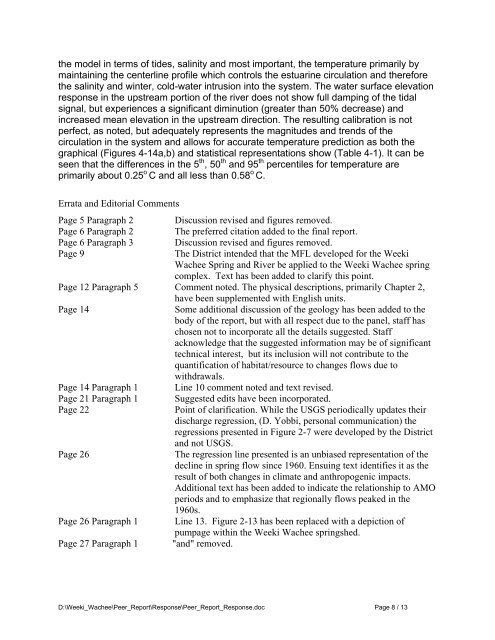Weeki Wachee River System Recommended Minimum Flows and ...
Weeki Wachee River System Recommended Minimum Flows and ...
Weeki Wachee River System Recommended Minimum Flows and ...
You also want an ePaper? Increase the reach of your titles
YUMPU automatically turns print PDFs into web optimized ePapers that Google loves.
the model in terms of tides, salinity <strong>and</strong> most important, the temperature primarily by<br />
maintaining the centerline profile which controls the estuarine circulation <strong>and</strong> therefore<br />
the salinity <strong>and</strong> winter, cold-water intrusion into the system. The water surface elevation<br />
response in the upstream portion of the river does not show full damping of the tidal<br />
signal, but experiences a significant diminution (greater than 50% decrease) <strong>and</strong><br />
increased mean elevation in the upstream direction. The resulting calibration is not<br />
perfect, as noted, but adequately represents the magnitudes <strong>and</strong> trends of the<br />
circulation in the system <strong>and</strong> allows for accurate temperature prediction as both the<br />
graphical (Figures 4-14a,b) <strong>and</strong> statistical representations show (Table 4-1). It can be<br />
seen that the differences in the 5 th , 50 th <strong>and</strong> 95 th percentiles for temperature are<br />
primarily about 0.25 o C <strong>and</strong> all less than 0.58 o C.<br />
Errata <strong>and</strong> Editorial Comments<br />
Page 5 Paragraph 2 Discussion revised <strong>and</strong> figures removed.<br />
Page 6 Paragraph 2 The preferred citation added to the final report.<br />
Page 6 Paragraph 3 Discussion revised <strong>and</strong> figures removed.<br />
Page 9<br />
The District intended that the MFL developed for the <strong>Weeki</strong><br />
<strong>Wachee</strong> Spring <strong>and</strong> <strong>River</strong> be applied to the <strong>Weeki</strong> <strong>Wachee</strong> spring<br />
complex. Text has been added to clarify this point.<br />
Page 12 Paragraph 5 Comment noted. The physical descriptions, primarily Chapter 2,<br />
have been supplemented with English units.<br />
Page 14<br />
Some additional discussion of the geology has been added to the<br />
body of the report, but with all respect due to the panel, staff has<br />
chosen not to incorporate all the details suggested. Staff<br />
acknowledge that the suggested information may be of significant<br />
technical interest, but its inclusion will not contribute to the<br />
quantification of habitat/resource to changes flows due to<br />
withdrawals.<br />
Page 14 Paragraph 1 Line 10 comment noted <strong>and</strong> text revised.<br />
Page 21 Paragraph 1 Suggested edits have been incorporated.<br />
Page 22<br />
Point of clarification. While the USGS periodically updates their<br />
discharge regression, (D. Yobbi, personal communication) the<br />
regressions presented in Figure 2-7 were developed by the District<br />
<strong>and</strong> not USGS.<br />
Page 26<br />
The regression line presented is an unbiased representation of the<br />
decline in spring flow since 1960. Ensuing text identifies it as the<br />
result of both changes in climate <strong>and</strong> anthropogenic impacts.<br />
Additional text has been added to indicate the relationship to AMO<br />
periods <strong>and</strong> to emphasize that regionally flows peaked in the<br />
1960s.<br />
Page 26 Paragraph 1 Line 13. Figure 2-13 has been replaced with a depiction of<br />
pumpage within the <strong>Weeki</strong> <strong>Wachee</strong> springshed.<br />
Page 27 Paragraph 1 "<strong>and</strong>" removed.<br />
D:\<strong>Weeki</strong>_<strong>Wachee</strong>\Peer_Report\Response\Peer_Report_Response.doc Page 8 / 13
















